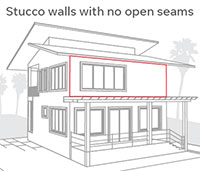PRESIDENT’S LETTER
Teaching Stucco to School Kids
Nick Brown, Merlex
 “I want the kid in the back row to see another career path for himself.”
“I want the kid in the back row to see another career path for himself.”
Today’s school kids are told to focus on computers, foreign languages, and math, so they have the skills to compete in the Service economy. But this leaves kids with other skills thinking they can’t succeed in the new economy – we were those kids a few decades ago. Maybe we chose to go into building materials manufacturing for the tangible satisfaction of seeing our product on new homes. Or we liked working with our hands. It was easier for us to see a career path for ourselves than for kids today with the same interests we had.
This is why I started teaching a real-world one-day class for my friend’s Economics class at Long Beach Poly High. I want these kids to see manufacturing lives on in this country. The lesson makes the economics they are learning seem relevant to a real-world job they could some day have. And I want the kid in the back row to see another career path for himself.
We talk about the economics of running a real business – variable and fixed costs, how pricing decisions get made, why people get laid off when business slows down. And we use fictional stucco companies to demonstrate the points. The kids get into it when they have to offer a special price for a big job and compete with each other. The exercise raises questions from the kids like:
“Don’t the companies have the incentive to get together and agree to keep prices high?” (Yes, but you absolutely cannot collude.)
“Even if you get a big job, how do you guarantee that the customer uses your product next time?” (Service and relationships)
“Can I ship in my product from China so I have a cost advantage and can offer a lower price to get business?” (Not in this lesson, but that’s definitely possible for an enterprising company that wants to build a new brand in the U.S.)
Sherry Davis, of Carmeuse Industrial Sand Co., has done much the same thing in the San Juan Capistrano community, with a focus on mining. In the process, she helps communicate the benefits of having mining industry in Southern California, and helps public relations in her community that goes a long way toward staving off the city planners who often seem bent on driving industries like ours out of town.
The SMA Board has voted to make this type of school outreach a formal program this year. We’re going to develop a model lesson plan for all our members to use in their local schools like mine and Sherry’s. If each of our member companies gets out in their community schools just once a year, I know that our industry will get a public relations boost out there, kids will learn something important and real-world, and the day out of the office will give you a morale boost, too. I think you’ll find, like Sherry and I have, that the school experience will remind you why you went into this industry, and what potential our young people have to improve on what they will some day inherit from us – a prosperous manufacturing sector with fulfilling careers for those who don’t embrace the new service economy.
More information on the SMA School Outreach Program to follow. Contact Norma Fox to express your interest in helping shape the program. 
Feature Articles
Dealing with Legal Disputes in a Tough Economy
Bjorn C. Green, Esq., Demler, Armstrong & Rowland, LLP
The current business climate, weakened by the recession and made worse by the crisis in mortgage lending, has hit the construction industry particularly hard. Many of our clients are family-owned and run businesses that have been around for generations, and they are struggling. Sons and daughters are doing what their parents and grandparents did before them – proudly helping build homes, schools and businesses for their communities. The knowledge and experience that these people bring to the table is irreplaceable, and the quality of their products is unparalleled, but the demand for construction materials and services, while slowly increasing, is still well below levels seen five or ten years ago.
While business is down in the construction manufacturing and service industries, business is up for lawyers. With more limited options as a result of financial instability, many are taking their disputes to court. Lawyers, many of whom make their living by the billable hour, are happy to take on the role of advocate or defender for often-desperate clients with limited knowledge of the system, and the longer a dispute drags out, the more money the lawyers on both sides of the fight make – win or lose. While there might certainly be spirited debate on the topic, many lawyers would argue that they too need to earn a living and, by fighting every last battle to the finish, they are just following their clients’ instructions.
Please don’t misunderstand. Not all lawyers are sharks. Many of my best friends are attorneys, and I have tremendous respect and admiration for the integrity, work ethic and passion they bring to the table in the representation of their clients. These people make the headaches of their clients their own. They lose sleep at night figuring out solutions to their clients’ difficult problems, and take wins and losses as personally as if they were the ones whose livelihoods were on the line. Sometimes, disputes are so heated and the parties are so polarized that there is no other way – you need a smart, experienced, aggressive lawyer with a big stick to beat the other side down.
As appealing as the “club” approach to litigation might be, however, there is usually a better way, especially when money is tight. Litigation is not only expensive, but it is emotionally draining. Parties involved in court battles usually take things very personally, and big lawsuits can become all-consuming. Given the economic realities confronting those in the construction industry today, time, energy and money invested in a lawsuit are things that many can ill afford. Unfortunately, the person those in need of help turn to for advice about how to confront a difficult legal situation can be the person who stands to gain the most from a long, drawn-out lawsuit.
Set forth below are a few things worth considering both before and during a dispute:
- Is a lawsuit really the best way to go? Litigation is an expensive and inefficient way to resolve many small and medium-sized disputes. Parties can fight for years and spend as much (or more) on lawyers than the case is worth and, after all of the money and heartache, the case gets settled, leaving everyone unhappy. Rather than wasting years and scarce resources fighting past the point of diminishing returns, think about mediation as a means of quickly settling things early on. Perhaps compromise seems less satisfying than suing someone, but would you rather spend years and tens of thousands of dollars (or more) waging war, only to reach the point that you are so fatigued and cash-strapped by the process that you settle anyway? Most cases settle, so why not get it over with so that you can move on?
- If you can’t reach a compromise or are not interested in mediation, think about arbitration or a private trial. Lawyers or retired judges are available to serve as triers or fact, and, if you need someone to decide who is “right” in a dispute, an arbitrator (or panel of arbitrators) or private judge can serve in that capacity, and can probably get you a result much faster than the court system. A word of caution, however: while arbitration or judicial reference might enable you to resolve a case more quickly, it is not cheap, and your rights to appeal if things don’t go your way are limited.
- Before embarking on the prosecution or defense of a lawsuit, make sure you have a complete understanding of contractual defense and/or indemnity provisions, or applicable insurance variables. While material or product suppliers may be less entangled in contractual requirements than contractors or subcontractors, litigants need to comprehend the import of the “small print” contained in contract documents. Language contained in many contracts can fundamentally affect your exposure and change the outcome of lawsuits. Many don’t realize that an indemnity obligation might force you to pay the attorneys’ fees of another party, even if you are ultimately found to be without fault. To a lay person, this defies common sense, so figure this out at the beginning of the process, rather than being told at the end that you have won the battle but lost the war.
- Understand your insurance picture. Do you have a deductible? Self insured retention? How much is it? Are their coverage limitations for things like “your work” or “your product”? Is it worth it to get the insurance carrier involved? If they deny coverage, should you challenge that denial? What are your options and remedies when the carrier you thought was supposed to take care of you fails to do so?
- Pick the right lawyer. Ask around. Interview a few. Get references. Have they tried cases, or are they specialists in working a file for years and then advising the client to settle? Do they have experience with the issue you are confronted with? Ultimately, the lawyer you hire will carry at least part of your financial well being in his or her briefcase – you had better trust them.
While the attorney’s job is to provide counsel and representation to a client, the client needs to be informed about the process, the risks and benefits of participating in a lawsuit, and what the costs (financial and emotional) of litigation are likely to be. In today’s business climate, we need to work together to resolve our differences, because the outcome of all-out war is probably not going to be what is expected or desired by either side.
Construction Market Forecast: The General Economy Is Seeing Mixed Signs
RALEIGH, N.C., June 10, 2011 – FMI, the largest provider of management consulting and investment banking to the engineering and construction industry, announces the release of the Construction Outlook: Second Quarter 2011 Report.
In FMI’s Construction Outlook for the second quarter 2011, there are signs that the economy is recovering – even for contractors – but you have to look hard to see them. The stock market has taken on a more bullish trend since the bottom of the recession, but that bull has yet to visit Main Street, which is struggling to fix the potholes, not to mention the infrastructure buried beneath the streets.
The costs of construction materials have been rising faster than the slow increase in construction activity would suggest. Recently, commodities investors woke up to the idea that the recovery may once again be delayed. Their concerns are justified when one considers the uncertainties in the news, including a slowdown in GDP growth to just 1.8% after a solid fourth quarter pace of 3.1%. Construction markets are also affected by national and global uncertainties including the ongoing political upheaval in the Middle East and northern Africa; the resurgence of concern over the European debt crises, particularly Greece; and the ongoing budget battle in the U.S. Congress.
Report highlights include:
- Total construction in 2011 will climb 2% after declining 9% in 2010.
- Construction employment remained abysmal and little changed since the depth of the recession.
- The nonresidential sector will decline just 2% in 2011 after a 19% decline in 2010.
- Most of the areas showing growth, excluding residential, are in markets related to infrastructure.
- Sewage and waste disposal, and conservation and development construction will contribute to a positive climb in the nonbuilding segment.
- Power will continue to be a growing construction market (2% growth for 2011) as there is no sign that our need for more of it will abate. We expect growth to accelerate over the next five years as more attention is paid to renewable energy sources.
- The much-expected nuclear renaissance could stall once again as regulating bodies and engineers reassess safety measures based on the devastating results of multiple catastrophes at Japan’s Fukushima nuclear plant.
Green Choices
Kevin Wensel, Omega Products Int’l
Portland cement-based plaster systems are an excellent green choice as the exterior wall cladding for sustainably built buildings because:
Durability: A portland cement-based plaster system has a life-cycle of 50+ years, which is one of the longest expected service lives for exterior cladding. There is a high financial and ecological impact when the cladding of a building needs to be replaced, so stucco’s long life-cycle is good for the building owner’s wallet and the environment.
Maintenance: The stucco requires very little maintenance. As a cement-based product, it is mildew, rot, termite, and fire-resistant, while also have a high impact resistance. When integral colored cement-based stucco finish is used, then the building does not need to be painted or re-painted.
Embedded Energy: The embedded energy is the amount of energy it took to manufacture and transport a product. Cement-based plaster is comprised mainly of sand, portland cement, and lime. The embedded energy of mining sand is relatively low, and it is typically sourced close to the jobsite. The embedded energy of cement and lime is high because of the high temperatures required in the kilns to manufacture the materials. Though cement and lime producers have, and will continue, to implement new technologies and methods to reduce the net energy required to make the materials, so the embedded energy is going down with time. Also, the energy required for transportation of cement and lime is low because most of the raw materials are sourced near the plants and the plants are typically close to most jobsites. The typical plaster mix is approximately 1 part cement to .75 part lime to 3 parts sand, so sand with the lower embedded energy is a majority of the plaster mix. Additionally, some plaster mixes use fly ash or other materials with recycled content, which further reduces the energy used to make the product. Furthermore, when the long life-cycle and low maintenance are considered, the embedded energy of the plaster system over the life of the building is better than most other exterior cladding options.
Energy Efficiency: There are plaster systems that incorporate a layer of rigid insulation board. The use of continuous insulation exterior to the studs greatly increases the energy efficiency of the wall.
Cost: The overall cost of cement-based plaster systems is one of the lowest. The cost of installing the product is relatively low, requires very little maintenance, and does not need to be replaced for a long time.
Greenhouse Gases, Cap and Trade, Carbon Allowances: Cleaner Air or Politics as Usual?
Tom Himes, EHS Manager, Carmeuse Industrial Sands
Whether we recognize global warming as science fiction or fact, one thing is certain: industry will have to manage it. Federal and state regulators are using existing laws to limit emissions of green house gases (GHGs) while the politicians are fighting to delay any new bill that mentions the words. The controversy hits at the core of our society. For some, more restrictions on industry will mean fewer jobs and slower economic recovery. Others think that now is the time to act and that waiting will only make matters worse.
The Clean Air Act treats pollution that causes global warming like any other air pollution. In 2007, the Supreme Court ordered the EPA to decide, based on the best available science, whether these pollutants pose a danger to public health or welfare. In December 2009, the EPA responded to the Supreme Court by issuing an “endangerment finding” determining that carbon dioxide and five other greenhouse gases are dangerous to both health and welfare. This finding allows the EPA to use its authority to develop standards that will reduce global warming pollution.
The Natural Resources Defense Council posts the following summary of potential effects caused by current and projected concentrations of the six key greenhouse gases:
- Increased frequency, duration, and intensity of heat waves. The associated health problems of heat cramps, heat exhaustion, and heat stroke will be become increasingly common. The very old and very young are especially vulnerable, as well as those who are poor, socially isolated or who have chronic illnesses.
- Increased air pollution. Increased temperatures cause increased production of ground level ozone, the main component of smog. This will increase rates of asthma and other respiratory diseases. It also makes breathing difficult for those who already have cardiac or respiratory ailments. Pollen production and allergies are also increasing as a result of increased CO2 concentrations.
- Infectious diseases. Climate change is altering the range of disease-carrying organisms. West Nile virus carried by mosquitoes was not as prevalent in the United States until recently. More than 25,000 cases and more than 1,000 deaths have been recorded.
- Extreme weather events. This includes severe storms, increases in both drought and flooding, and associated features such as erosion and wild fires. The commenter indicates that we simply do not have the public health capacity to respond to increasing numbers of large-scale disasters that are difficult to predict.
California’s AB 32 — Forging Ahead
Known as the “Global Warming Solutions Act of 2006,” AB 32 directs the California Air Resources Board (ARB) to develop actions needed to reduce greenhouse gases by 2020.
One strategy is the cap-and-trade program, which works by giving a polluter a permit from the state that lets it release a certain amount of carbon dioxide and other greenhouse gases into the air. If a company emits less than its allotted amount of pollution, it can sell its unused “carbon credits” in a marketplace. Polluters can even make a profit if demand for the permits is high and their prices exceed the initial cost.
Although cap and trade is only one of the eight strategies outlined by the ARB’s Scoping Plan, it has experienced the most challenges.
A San Francisco Superior Court Judge recently ruled that state air quality regulators failed to properly consider alternatives to the cap-and-trade program. The judge ruled that the failure to consider alternatives violated state environmental law, so the California Air Resources Board must conduct further review before implementing the plan.
So it’s back to the drawing board for ARB to see how it will get the last remaining wedge of its Emissions Reduction “pie.” ARB is expected to have the new analysis completed by early summer, at which time interested stakeholders will have an opportunity to weigh in.
New SMA Member Profile
Chris Kreple, ThermalStar Product Manager, Atlas EPS
Atlas EPS specializes in the development and manufacture of innovative, high-quality, HFC- and HCFC-free Expanded Polystyrene (EPS) rigid insulation for construction, packaging and OEM products. With plants across the North America, Atlas EPS – headquartered in Byron Center, Michigan, at the largest EPS manufacturing plant in the industry – can provide product solutions coast-to-coast. Since the mid-1960s, Atlas EPS has played a significant part in the growth of technology and product applications in the EPS industry. As of February 2010, Atlas EPS proudly announces its maiden membership to both the SMA & PCASC ranks.
With a dedicated Engineering Department and Quality Assurance Group, we can work with you to ensure the best possible product designs at a competitive price. Whatever your fitness-for-use may be, the Atlas EPS team can help translate your requirements into viable product solutions. Atlas EPS products are third-party tested, certified and listed with ICC-ES, Underwriters Laboratories, Factory Mutual and ONNCCE.
In the second quarter of 2010, Atlas EPS launched the ThermalStar® brand of construction products. This product line includes below grade products, roofing products, exterior wall products, and vegetative roofing products.
Included in the ThermalStar product line, are the enhanced EPSX™ products which include X-Grade, X-Pro and XTR. These product offer integrated termite resistance, engineered compressive resistance, enhanced moisture resistance, and warranted R-values. ThermalStar EPSX products are also a distinctive orange color so that construction professionals can easily identify this superior product.
The newest member of the ThermalStar EPSX rigid insulation family of products is XTR. ThermalStar XTR is used for continuous insulation under exterior stucco systems. California Title 24 has made “One Coat” stucco systems much more popular since One Coat stucco delivers quick installation over 2×4 framing, reduced material costs, and most importantly offers continuous exterior insulation. This continuous insulation makes meeting the Title 24 requirements much easier and cheaper than using traditional “Three Coat” stucco over costly 2×6 framing which would then require more and therefore more expensive cavity insulation.
ThermalStar XTR has a number of attributes that make it the preferred choice for One Coat stucco systems:
• ThermalStar XTR comes with a twenty year warranty on the insulation value
• ThermalStar XTR also comes with a twenty year warranty on the termite treatment applied to the product
• ThermalStar XTR is 100% virgin EPS which enhances physical properties
• ThermalStar XTR contains a proprietary wax matrix that enhances moisture resistance
• ThermalStar XTR meets ASTM Type II standard
• ThermalStar XTR has a compressive strength of 15 psi
• ThermalStar XTR is available 2’x8’ or 4’x8’ with the long edges being T&G
• ThermalStar XTR is a nominal 1 -1/16″ thick
• ThermalStar XTR has dimpling on the face that enhances the bond between the rigid insulation and the stucco components
• ThermalStar XTR comes standard with water management grooves on the back side with signifying marks on the front to allow for easy alignment of the grooves
As the demand for energy efficient homes continues to grow, builders and developers have a new option for meeting that demand and the associated regulations – ThermalStar XTR. These builders will also benefit from easy installation and the piece-of-mind that they are using a superior product backed by an industry leader.
For more information see http://atlaseps.com/products/thermalstar/side-wall-wall-insulation
Carbon Trading Programs Struggle – Remain Optimistic
Tina McIntyre, TXI Riverside Cement
Carbon trading in general has also had its share of challenges. In May 2011, New Jersey pulled out of the Regional Greenhouse Gas Initiative (RGGI) – a regional trading house for carbon credits whose members include 10 Northeastern states.
New Jersey’s governor Chris Christie said the program’s allowances were never expensive enough to change behavior, and that New Jersey has brought its carbon emissions below its 2020 goal as a result of market forces rather than cap-and-trade. Any benefits from the RGGI tax will also now be miniscule in comparison to those from New Jersey’s incentives for wind, solar and natural gas generation, Christie said.
New Hampshire and Delaware may follow suit; however, RGGI experts feel that this is a minor set back to the initiative. Point Carbon’s Emilie Mazzacurati states that that “longer term outlook is not necessarily negative.”
Should California’s cap-and-trade program succeed, carbon allowances will be traded on the Western Climate Initiative (WCI). WCI’s members include several Western states as well as most Canadian provinces.
The National Resource Defense Council states, “These groundbreaking policies are driving down pollution, improving public health, creating new economic and job opportunities, and positioning California as a global leader in the push for clean energy solutions.”
Where Are We Headed?
The current political arena has put climate change on the proverbial back-burner. But regulators continue to use existing laws and will continue to develop new standards that will limit the emissions of GHGs.
The Portland Cement industry is facing several new significant air quality regulations under consideration by U.S. EPA. These include updates to:
- New Source Performance Standard for Portland Cement Plants (NSPS Subpart F)
- National Emission Standards for Hazardous Air Pollutants for Portland Cement Plants (NESHAP Subpart LLL) also known as the Portland Cement MACT
- Proposed revisions to the NSPS for Nonmetallic Mineral Processing Plants (Subpart OOO) and NSPS for Coal Preparation Plants (Subpart Y)
- Greenhouse gas (GHG) reporting rule
The NSPS Subpart F requirements are significant because they will, for the first time, regulate NOx and SO2 from new and modified cement kilns – an example of how GHGs will be regulated in the future.
Plan for Change
The climate change battle will be a long one, and the debate over whether GHGs are to blame may never be won. The reality is that an air permit is required to operate, and there are existing rules that allow the regulators to limit emissions of GHGs.
The initial impact is affecting large sources such as power companies, refineries, and specific industries. But all industries will be impacted in one way or another, whether it is from the higher cost of utilities, transportation, or raw materials. It will also mean possible delays in permitting for new facilities or for major modifications on equipment that was previously not considered a source.
Ignoring the battle or waiting for a resolution is not the best strategy; it may have already impacted your business.
Pre-blended Portland Cement Plaster Basecoats
Ben Garcia, Expo Stucco Products
Construction specifications setting forth the minimum requirements for plastering work must be closely adhered to, whether stated in industry-wide standards and guide specifications or in local building codes. These written specifications establish acceptance requirements for the quality of materials and workmanship.
Portland cement plaster is a combination of cementitious material, fine aggregate, lime and water. When properly proportioned, these materials will provide a hard, durable plaster surface that provides reasonable resistance to weather and cracking.
A major concern voiced by many experts in the plastering field is the variation and lack of control in job site mixing of sand and cement used in portland cement plaster for the scratch and brown coats. Sand added in excess of recommended parameters can seriously affect the integrity on the entire wall assembly.
Another growing issue is the use of sand piles on job sites. At times restricted sites and multi-story projects cannot accommodate the space required for these large mounds of sand. Some organizations restrict sand piles over concerns of airborne dust and run off in the case of storms.
The high cost of on-site injuries is a challenge. Health and safety concerns have increased over the shoveling and heavy lifting associated with field mixing. An average of 383 injuries occur per every 10,000 workers per year.
(Source: Nonfatal Occupational Injuries and Illnesses Requiring Days Away From Work, 2008, Bureau of Labor Statistics, 11/24/09, http://www.bls.gov/news.release/osh2.nr0.htm)
Preblended basecoat mixes were developed to solve these challenges. Factory blended plaster mixes are specifically designed to conform to ASTM and IBC requirements for scratch and brown plaster applications. What’s unique is that the mixing happens at the factory, not on the jobsite.
These mixes are complete requiring only the addition of water. This control of the mix ratio at the factory eliminates the inconsistency associated with job-site mixes. This provides a consistent mix from batch-to-batch which aids in producing a uniform, durable basecoat.
Factory blended portland cement plaster has excellent pumping and troweling properties for the contractor, while providing the building owner with a durable plaster.
There is no sand to shovel. All a contractor needs is to start the mixer and add water, saving time, space and possibly money.





